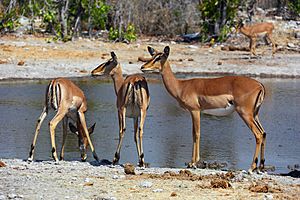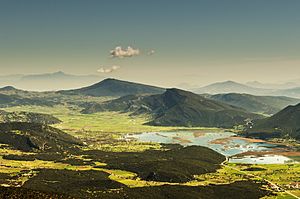Depression (geology) facts for kids

A watering hole is a natural dip where water collects for animals to drink.
In geology, a depression is a landform that is lower than the area around it. Think of it like a big dip or a bowl in the ground. These dips can form in many different ways, often over thousands or millions of years.
Contents
How Depressions Are Formed
Depressions can be created by several natural processes. Each type leaves a unique mark on the Earth's surface.
Formed by Erosion
Erosion happens when natural forces like wind, water, or ice wear away the Earth's surface.
- Blowout: This is a dip made by strong winds. It often happens in sandy areas like sand dunes or dry soils.
- Glacial Valley: Imagine a giant ice river, called a glacier. As it moves, it carves out long, U-shaped valleys, which are a type of depression.
- River Valley: Rivers also carve out land. Over time, the flowing water cuts into the ground, forming valleys.
- Sinkhole: These are holes that form when the ground above an empty space collapses. They are common in areas where rocks like limestone can dissolve easily.
- Sink (geography): This is a closed dip in the land that usually holds a lake. The lake might be there all the time or only during certain seasons. Sometimes, it's a salt flat or a dry lakebed.
- Panhole: A shallow dip or basin worn into flat, solid rock.
Formed by Collapse
Sometimes, the ground can simply fall in, creating a depression.
- Kettle: These are shallow, water-filled holes. They form when large chunks of ice from a melting glacier get buried in dirt and then melt away.
- Thermokarst Hollow: This happens in very cold places where the ground is frozen solid (called permafrost). When the permafrost melts, the ground loses volume and sinks, creating a hollow.
Formed by Impacts
- Impact Crater: These are bowl-shaped depressions made when something from space, like a meteorite, crashes into the Earth.
Formed by Sediment
- Sedimentary Basin: This is a large area where lots of sediment (like sand, mud, and pebbles) has piled up. The weight of all this sediment pushes the ground down, making the basin even deeper.
Formed by Earth's Movements
The Earth's crust is made of huge plates that are always moving. These movements can create depressions.
- Structural Basin: This is a large dip in the land caused by the Earth's crust bending downwards. The Hawaiian Trough is an example, where the weight of the Hawaiian Islands pushes the seafloor down.
- Graben or Rift Valley: These are long, sunken areas that form when the Earth's crust pulls apart. The Dead Sea area is a good example of a pull-apart basin.
- Oceanic Trench: These are very deep, long depressions found on the ocean floor. They form when one tectonic plate slides underneath another.
- Basin Formed by an Ice Sheet: When a huge ice sheet sits on land, its massive weight pushes the land down. After the ice melts, the land slowly bounces back up, but it leaves a depression behind.
Formed by Volcanoes
Volcanic activity can also create depressions.
- Caldera: This is a large, bowl-shaped depression that forms after a big volcanic eruption. It happens when the ground above the empty magma chamber collapses.
- Pit Crater: These are smaller volcanic depressions. They form when the ground above a void (an empty space) sinks or caves in.
- Maar: This is a broad, low-relief volcanic crater, often filled with water to form a lake. It's caused by an explosive eruption when hot magma meets groundwater.
Famous Depressions Around the World
Here are some well-known depressions on Earth:
- Aral–Caspian Depression
- Caspian Depression
- Danakil Depression
- Georgia Depression
- Qattara Depression
- Turpan Depression
See also
 In Spanish: Depresión (geografía) para niños
In Spanish: Depresión (geografía) para niños
- Cryptodepression
- List of places on land with elevations below sea level
- Ponor

All content from Kiddle encyclopedia articles (including the article images and facts) can be freely used under Attribution-ShareAlike license, unless stated otherwise. Cite this article:
Depression (geology) Facts for Kids. Kiddle Encyclopedia.

